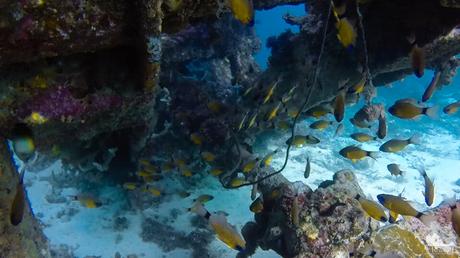
There are some wonderful places we hold dear in our hearts. It’s not just about their beauty, charm, availability of adventure, or people. More importantly, these amazing places actually changed our lives—our character, world perception, skill set, beliefs, or even our morals. The vibrant and rich Kontiki Reef in our very own home island of Mactan is one such place.
Why? Well, Kontiki Dive Resort was where we were first introduced to scuba diving and witnessed the incredible world beneath the sea. This was also where we successfully accomplished our PADI Open Water Diver certification. This was the dive resort where we brought friends and encouraged them to pursue scuba diving. For us, the place opened up a doorway to a whole new world of wonders, possibilities, and knowledge.
The Kontiki Dive Resort is located at the very end of a tiny bay. If you are expecting a beach with powder-fine white and and swaying palm trees, you’d be disappointed when you see the rough coral-stone wall. But if you’re looking forward to a great dive experience, then you have come to the right place.
Kontiki has facilities for divers of all levels including an in-house restaurant, fresh-water showers, toilets, and lounge areas. They also have cozy accommodations for divers who wish to stay for a few days.
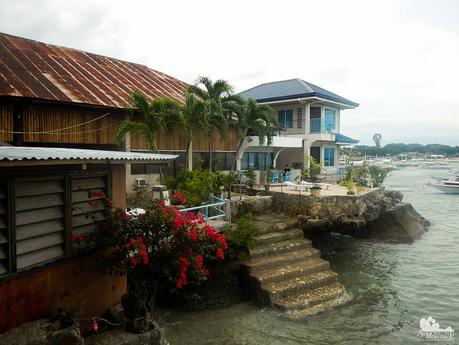
While the place may not be your idea of a postcard-perfect beach, it does have a stunning view of the Hilutungan Channel, one of the deepest channels in the country. During clear blue cloudless summer days, the blue sky and the turquoise sea seem to meld together seamlessly.

Island hopping and boat diving are very popular adventures here in Cebu. There are plenty of fast pump boats to take you to dazzling islands and lovely dive sites all around Mactan and the Hilutungan Channel. But even when there’s a large number of vessels, boats get fully booked during peak season.
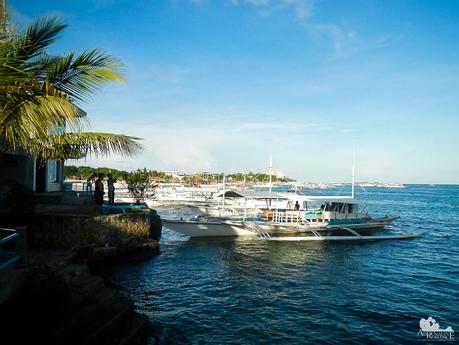
Once everyone was all accounted for, we suited up and headed towards the staging area at the bottom of a set of concrete stairs that leads into the sea. The stairs make it really convenient for divers to get in and out of the water quickly. Another good thing about Kontiki is that the geography of the inlet creates a pool-like environment in the shallows, making it an ideal place for people who want to enroll in a DSD or open-water certification course.
The tide was really nice and high during our dive, with the water reaching almost to the top of the stairs. As soon as we stepped off that large concrete platform, our feet was several feet off the bottom.
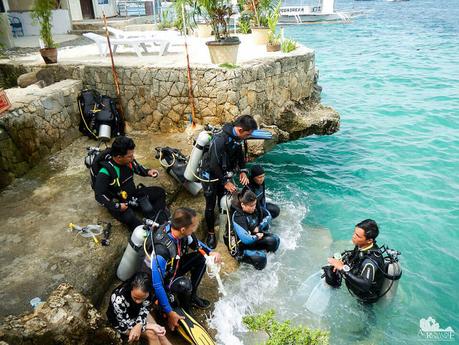
We had to swim a little further from the shore to reach the deep kantil, or drop-off. On the way, we pass by fertile sea grass beds. Sea grass are often called marine ecosystem engineers because they partly make their own habitat. The blades of grass slow down water currents and protect the coastline while their roots stabilize the seabed. In addition, they also generate oxygen and store the ocean’s carbon dioxide.
They also serve multiple purposes—food for sea turtles and manatees, nursery habitats for commercial fishery species, havens for shellfish and mollusks, and more.
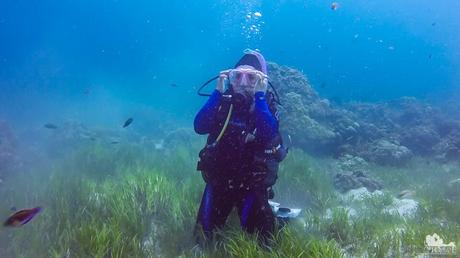
As we hunted for interesting creatures to photograph in the grass beds, a large silvery grunt approached and gave us a curious look. All fish in Kontiki are used to divers, and many come up right in front of our masks.
Grunts have a strange ability to produce sound by gnashing their teeth. Those clicking sounds you hear when you dive? Many of those are probably the grounds happily chatting.
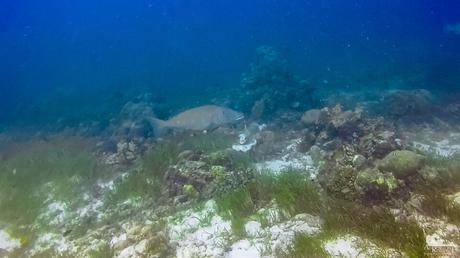
Nearby, we saw a colorful nudibranch slowly slithering in its search for food. The bright color serves to warn predators that it is not good to eat.
Nudibranches come in all colors of the rainbow, which make them favorite subjects for underwater macro photography. Too bad we only have an old GoPro Hero 3 Plus to take a photo of it; without a macro lens or a more advanced camera, we could not take a clear close-up image of it.
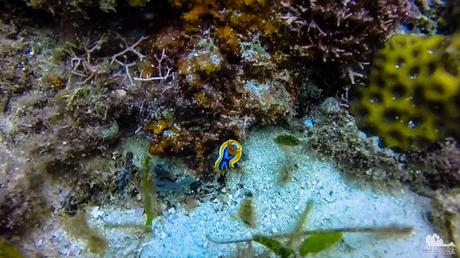
See those brownish-yellow things with white spots? Those are a bunch of glass anemone shrimp looking for some food. These shrimps are wildly distributed in tropical oceans as well as in Australia.
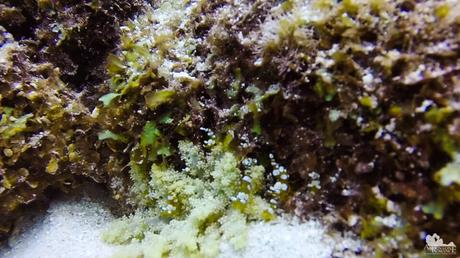
Hey, little guy, where are you going? A single glass anemone shrimp crawls around a stinging anemone, which is deadly to other fish.
Males are larger than females. They have a symbiotic relationship with stinging sea anemones, corals, and jellyfish.
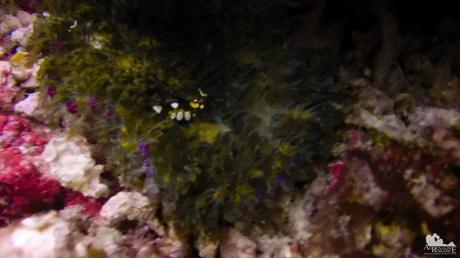
Common reef fish hover around lettuce leaf corals, a type of stony coral. These hard corals feed on drifting microscopic plankton that get ensnared in their tentacles. However, that’s just a small part of their food-acquisition mechanism. You see, these corals form a symbiotic relationship with light-sensitive algae called zooxanthellae. Through photosynthesis (i.e., the biological process of converting light to chemical energy), the zooxanthellae provides 90 percent of the coral’s energy requirements. Yes, corals are solar powered!
In return, the algae receive nutrients and carbon dioxide from the coral. Furthermore, zooxanthellae have better access to sunlight due to the coral’s elevated position from the seabed.
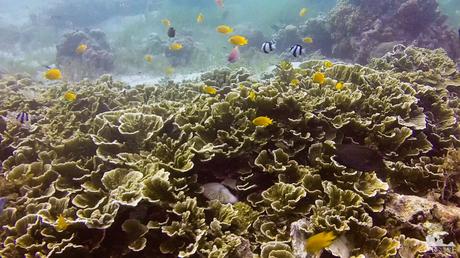
Our divemasters led us down into the kantil where we leveled off at 60 feet. The Kontiki Reef has one of the richest walls we’ve ever seen. Almost every square foot is covered with corals, sponges, hydroids, and algae that serve as homes, food, and hunting grounds for all kinds of marine organisms. That’s a large bubble coral and, in the background, a couple of fan sponges.
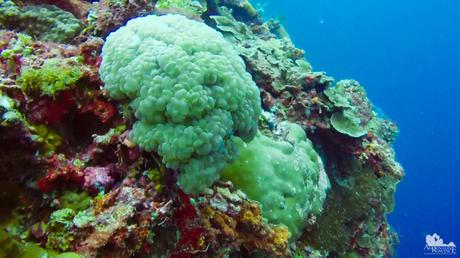
A young whip coral reached out to us. Those branches, or whips, contain colonies of tiny polyps. Whip corals usually come in a variety of bright, happy colors.
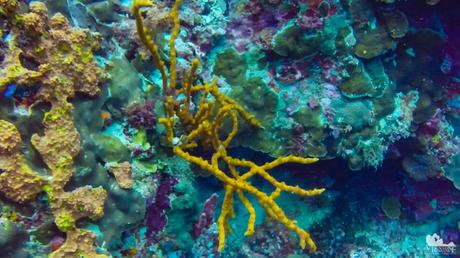
Soft coral sway gently with the current, creating a mesmerizing underwater ballet. Most soft coral have a symbiotic relationship with photosynthesizing zooxanthella, but they will also feed on free-floating plankton. They are essential in maintaining a healthy reef system as they provide habitats for fish, shrimp, snails, and other marine organisms.
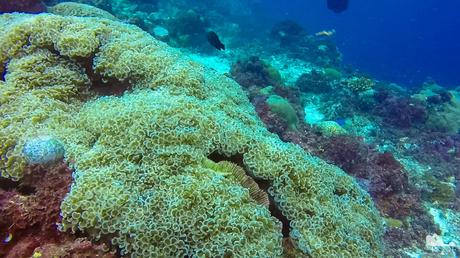
Hiding in one of the thousands of crevices was a small flagtail pipefish trying to stay in place against a relatively strong current. They flash their brightly patterned, paddle-like tails during courtship.
Like bluestreak wrasses, they sometimes take the role of cleaners, eating parasites and dead skin off other fish.
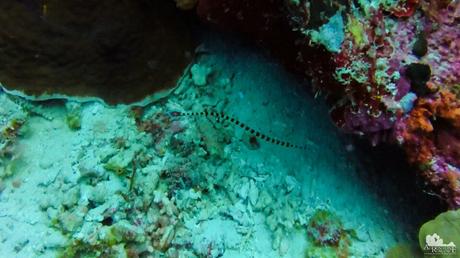
If not for our divemaster’s eagle-sharp eyes, we would have missed this perfectly camouflaged scorpionfish hiding in a tuft of kelp. It is an ambush predator, keeping itself invisible while waiting for small fish to swim by. If one gets too close, it opens its mouth at a fraction of a second, slurping up the fish inside its cavernous mouth. The scorpionfish is also one of the most venomous fish in the world. The venom in the sharp spines of its dorsal, pelvic, and anal fins packs a punch.
Can you see it? One of its eyes is visible.
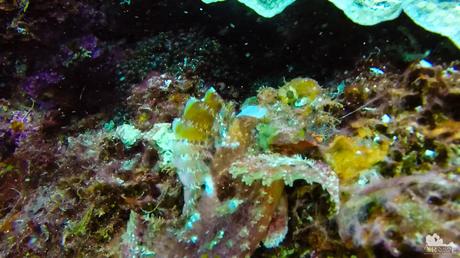
A fish with freckles? Oh yes! The territorial and aggressive freckled hawkfish sits on a strategic place in a coral—usually in a crevice or depression—with its head pointing outwards. In this position, they can grab their passing prey, just like a hawk. They also have a limited ability to change colors to camouflage themselves.

As we swam with the current, we came across piles of concrete rods on the seabed. We’re not exactly sure what they are, but one thing’s for sure. Fish love these structures, and they are making these rods their playground.
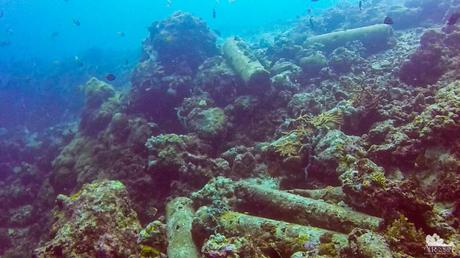
A school of small blue damselfish followed an invisible highway across the reef. Damselfish are pretty, and they make amazing displays in saltwater aquariums. Here in the wild, they are often eaten by predatory fish such as lionfish, frogfish, groupers, and the like.
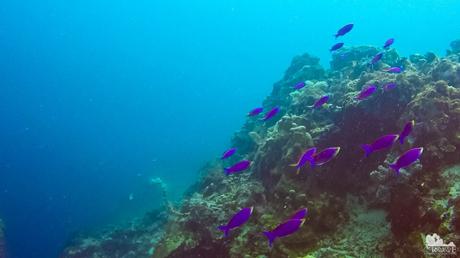
We consumed half the air in our tanks, so we started heading back towards the shallow part of the reef. As we reached the lip of the kantil, a clownfish cautiously peered at us from the safety of its protective anemone home.
The movie “Nemo” made us believe that clownfish are friendly and happy fish. Nothing can be farther from the truth. Clownfish are aggressive, and they will defend their anemone homes with unparalleled ferocity. They attack butterfly fish and mosshead sculpins that prey on their anemone homes. We even saw a clownfish attack a large sea turtle when the latter ventured too close to its anemone home.
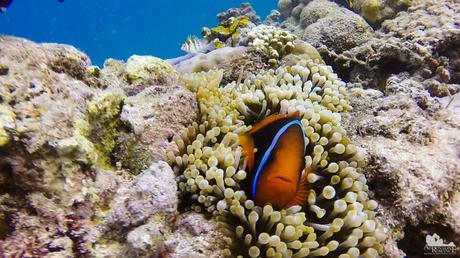
Keeping a cautious distance from the clownfish and anemone was this colorful dwarf hawkfish, which is common in Indio-Pacific waters. A male dwarf hawkfish keeps a harem of females. If the harem becomes large, one of the females become a male. It then tries to assume a dominant role. If the new male fails or if challenged by a more powerful counterpart, it may revert back to female.
In addition, hawkfish are immune to the stinging effects of fire corals.
Note: Before scuba divers criticize this photo, let us make everything clear. The diver in the photo WAS NOT touching a coral. He was holding the rock that the corals are attached to because the current was quite strong.
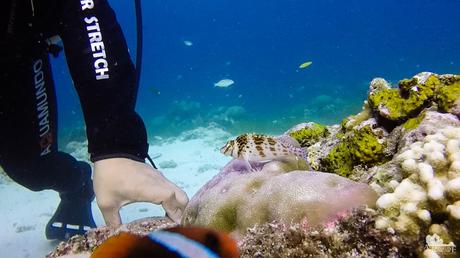
A couple of banded butterfly fish frantically swam away from an invading angelfish and a group of noisy, bubbling monsters.
In the course of their daily lives, fish get cuts and scrapes as they swim through corals. These minor injuries may get itchy and infected. To prevent that, they go to a cleaning station where bluestreak wrasses and cleaner shrimp would pluck the dead skin off the wounds.
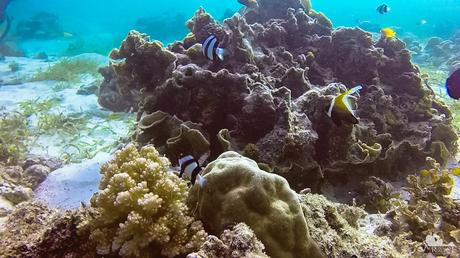
Pink tube sponges look like grotesque alien worms! Sponges are some of the simplest animals on earth. They siphon water through small pores called ostia and catch microscopic plankton with numerous sticky, hairlike flagella located inside its body. Once the plankton are trapped, the water is ejected out of its osculum, or the large main opening.
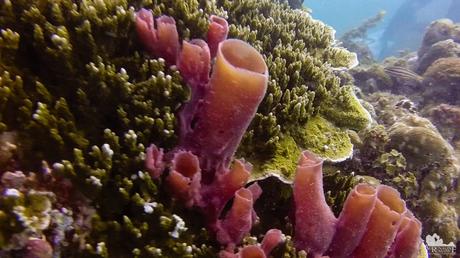
An aggregate of reef fish come up to us for a closer inspection. There is an overwhelming variety of reef fish in the Coral Triangle which our country is a part of. Each species has an important role in maintaining the delicate balance of the marine ecosystem. They are hunters, prey, cleaners, scavengers, propagators, and more.
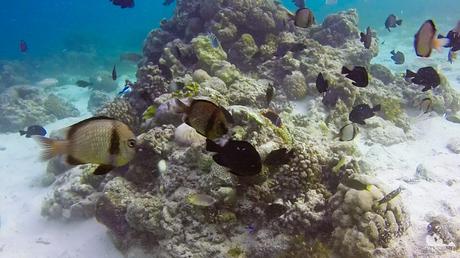
The current of the ebbing tide became really strong, and at times, we had to crawl along the sandy seabed to move. But we finally got to our destination. Looming in the blue like a giant iron monster with its cavernous mouth open is this coral-encrusted backhoe claw.
The claw was sunk sometime in the 90s as an artificial reef. After more than two decades underwater, it has become a successful, thriving artificial reef and a signature feature of the Kontiki dive site. This is a perfect example of mutualistic symbiosis between humanity and nature. Our junk ships, cars, and other unneeded heavy equipment have great use after all!

Let’s investigate this monster’s mouth. A large school of damselfish use the immovable claw as a reprieve against the the current and a shelter from the hot afternoon sun.
The kinds of fish that are attracted to artificial reefs vary wildly. In general, larger reefs such as shipwrecks attract larger fish. The Kontiki claw is small; so small damselfish, fusilers, butterflyfish, and similar species make this their home.
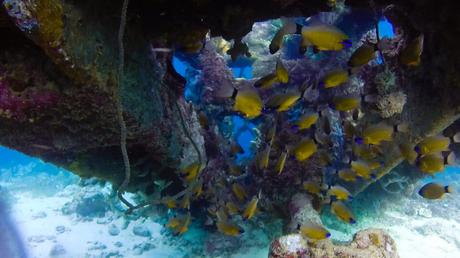
Visiting the Kontiki claw inspired us to proceed to take an Advanced Open Water Diver certification next year. Then, we plan to take a specialization in wreck diving among others. Wrecks are just so much fun to explore.
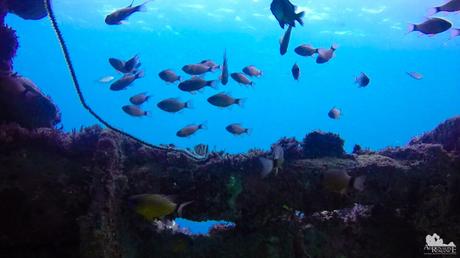
Time and an ideal substrate did excellently for this huge piece of iron. The entire surface of the claw is festooned with corals, sponges, algae, and hydroids. All these attract all kinds of reef fish, which in turn, become natural magnets for larger predatory fish.
In fact, in some of our dives in Kontiki, we have seen groups of barracudas stalking their prey near the claw. This time, however, we were unlucky; no barracuda was in sight.
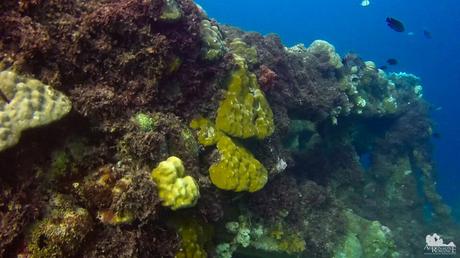
Three black sergeant majors rushed to defend their coral homes as we approached. Hahaha, they must have thought we were invaders. Sergeant majors are some of the most aggressive reef fish, and we have been attacked several times by them in some of our dives. Fortunately, their bites can’t penetrate human skin, each attack feeling like a sharp pinch.
Nearby, a large brown hawkfish waits for prey. He must have a heyday—the current pushes small damselfish to the hawkfish.
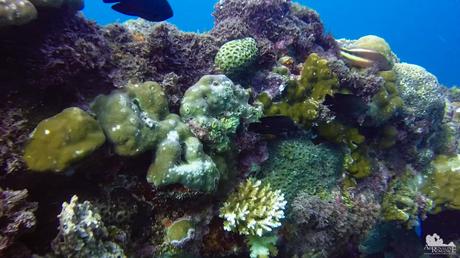
On our way back to shore, we came across this coral-encrusted rock that became a home for these colorful Christmas tree worms. Like nudibranches, Christmas tree worms come in all colors. Oh yes, the underwater world also celebrates Christmas!
The vibrant spiral is actually the mouth and gills of the creature. The microscopic hair-like cilia that cover the feather-like tentacles capture plankton from the water. If touched, they retract into the body in a fraction of a second!
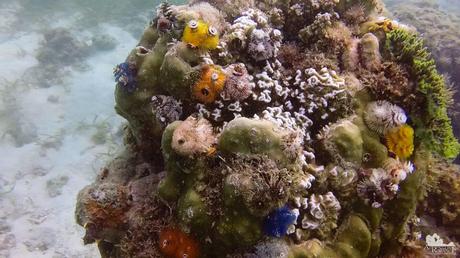
Despite the presence of a relatively strong current, it was an awesome dive. Thanks to these amazing, friendly, and funny divemasters who ensured us of a safe and exciting underwater sojourn.
Freelance divemasters and dive instructors love to hang out in Kontiki. Because of the popularity of the place, its ease of access, the reef’s close proximity to the shore, and the beautiful marine wildlife it harbors, Kontiki is one of their favorite places to hold scuba diving certification courses.
Want to be a scuba diver? Just approach any of the friendly people there. They’ll be happy to take you to an underwater adventure!
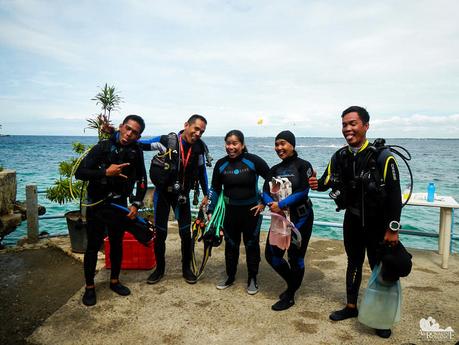
The blue realm teaches us a lot of lessons about the world we live in. It is a place where we learn humanity’s place and how everything is interconnected. We definitely grateful that we took such opportunity of humility and learning at the Kontiki Reef. Now, it’s your turn! Check out our video below!
Contact Details
For more information about Kontiki Reef, get in touch with Kontiki Divers using the following contact details:
- Business Name: Kontiki Divers / 7 Seas Dive Center
- Mailing Address: 7 Seas Aquanauts, Phil. Corp., PADI 5 Star Dive Centre S-2936, c/o Plantation Bay Resort & Spa, Marigondon Beach, Mactan Island, 6015 Cebu, Philippines
- Phone Numbers: 0917-323-5776
- Emails: [email protected] / [email protected]
- Website: Kontiki Divers
- Facebook Page: Kontiki Divers
- For English inquiries, contact Judith Ompad at [email protected]
- For German inquiries, contact Karl H. Epp at [email protected]
Kontiki Divers also offers PADI Dive Courses including specialties, dive safaris, island hopping trips, assistance on accommodations, and more.

